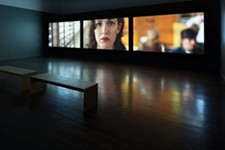“Jana Swec: Congitopia” at grayDUCK Gallery
It's the valuable give and take between Jana Swec and her collaborators that make this show consistent, as well as surprising
Reviewed by Sam Anderson-Ramos, Fri., March 24, 2017
Dr. Dre and GZA the Genius are two of my favorite producers. They work with numerous lyricists of varying styles and voices, but for anyone familiar with their sound, there is never any mistaking who the artist behind the artist is. At the same time, each knows how to get out of the way and let the featured artists spread their wings. It's a seamless collaboration guided by the aesthetic of a talented hand. That approach is rare in the visual arts, but Jana Swec has found a way.
"Congitopia" is a collection of 17 works, each a product of a collaboration between Swec and another artist. One of the standouts is Ora, with Adam Young. Ora is a mixed-media collage on a wood surface. A figure like a 19th-century shepherd relaxes in the crook of a hill, blowing on a harmonica with his legs crossed. Around him goats frolic and moon to the music in a landscape of earth-toned trees and plants. "The roots reached upwards," we are told at the bottom of the image. More text is painted and inked in spots around the landscape like whispers. "Constant constant constant constant constant travelers," one says in a wobbling yellow, buried among the green buds of a sprawling tree. "Went on growing," says black text even farther up the tree. Meanwhile the shepherd and goats caper at the scene's center. It's like a Marcel Dzama illustration, cartoonish but haunting, but what it also reminds me of is a colonial American genre painting, where crude people gather outside a town hall or farmhouse, riding horses or chasing chickens in a pastoral landscape, a church steeple far in the background. Ora has that same simplicity, the same honesty, a visual style out of folk art, as though it were made in an older world.
A theme that runs through most of the images is a tree-like, organic form that grows and twists in many directions. In the case of Ora, that would be the grand tree itself, buds streaming the span of the sky like galaxies, as well as the striated roots and hills that fold on themselves and frame the image. The form is also notable in Bruna, with Alexandra Valenti, an image of a twining, multi-colored creature that reaches from the sea into a sky of swarming white birds. Vega, with Julie Swec, is a photo of a girl seated with her back to us as tentacles, this time in black and white, swirl around her body. In Farah, with Jon Windham, the tentacles have grown fat and pink. They lay over the bottom two-thirds of the image like the surface of a soft planet or a gathering of intestines. The top of the image is pitch black. Floating there is a quiet, dense cloud, poised over the roiling pink mass beneath it.
Swec doesn't force her hand. It's her show, but the work has been the result of a dialogue, a relationship between one artist and another. The goal is a final product, something tangible that we can look at, but that end isn't the only one. Equally valuable is the ebb and flow of the conversation that brought the artists to a satisfying place. That give and take is what makes the show consistent, as well as surprising. Swec may have orchestrated the process, but ultimately she, and her collaborators, were at its mercy. That is as it should be.
“Jana Swec: Congitopia”
grayDUCK Gallery, 2213 E. Cesar Chavezwww.grayduckgallery.com
Through March 26













